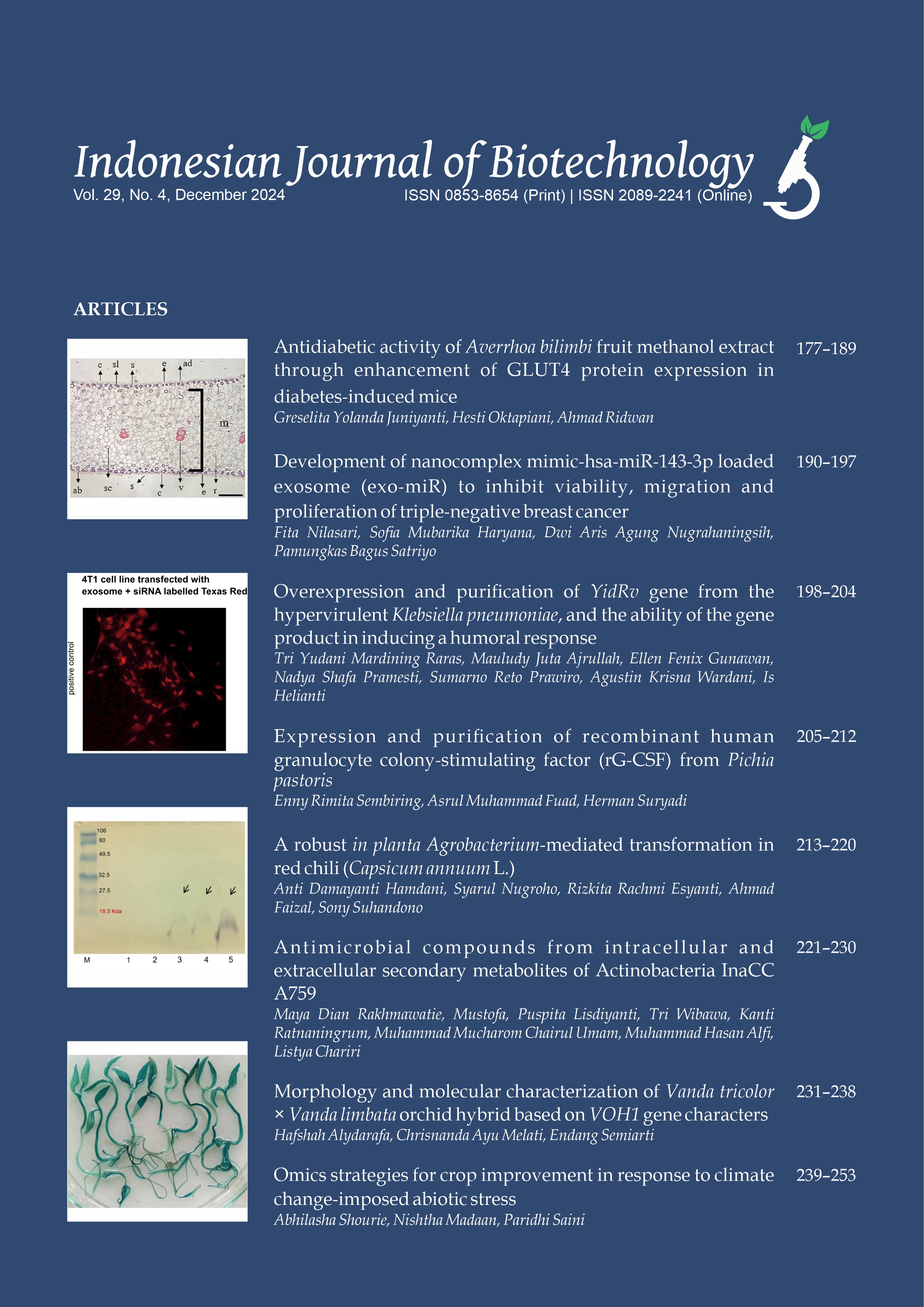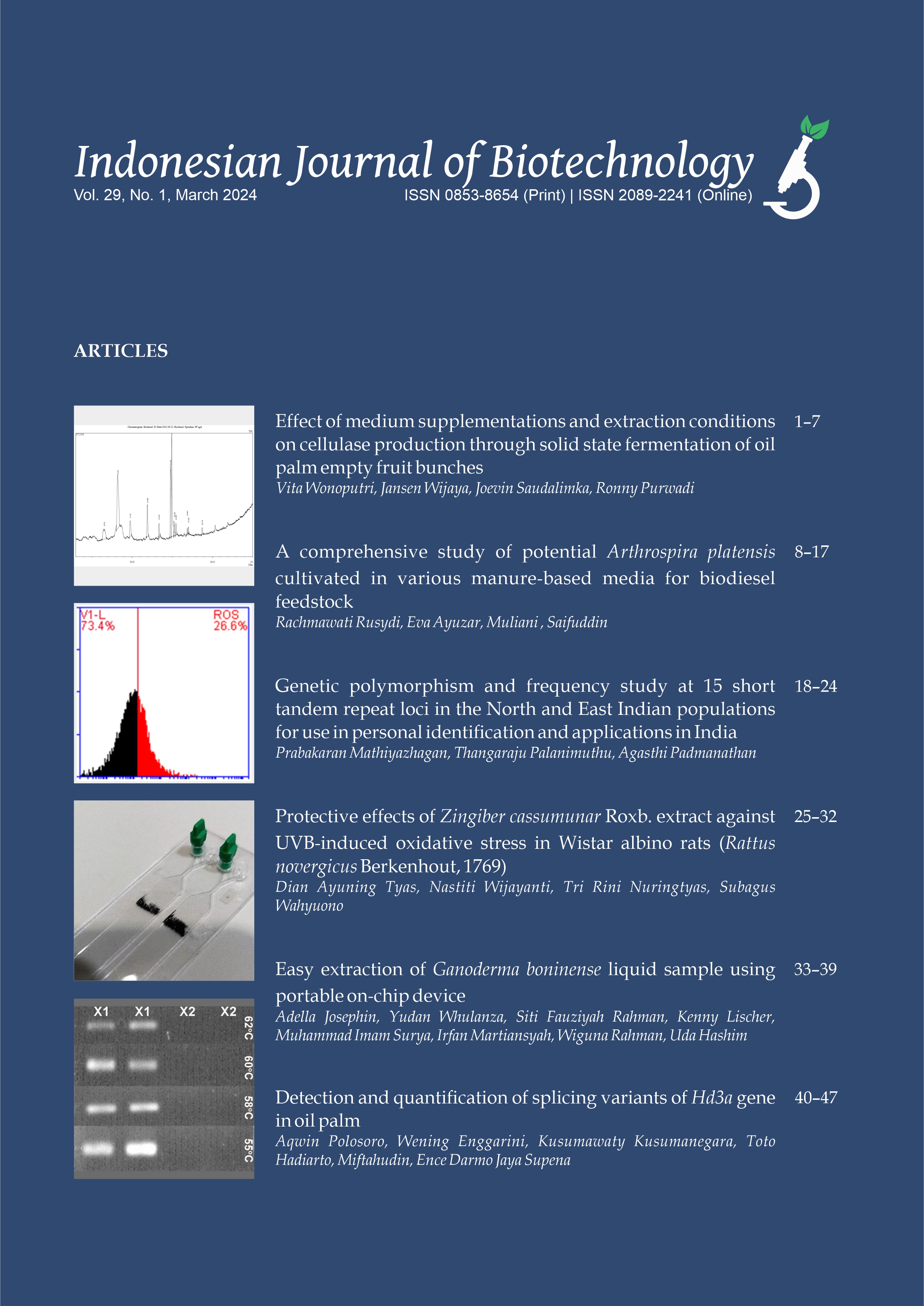Development of a dimer‐based screening system that targets PhoR, a sensor kinase of the two‐component regulatory system, in Mycobacterium tuberculosis
Nathanael Steven(1), Reza Aditama(2), Almira Alifia(3), Elvira Hermawati(4), Eri Bachtiar(5), Mellysa Rahmita(6), Azzania Fibriani(7), Yana Maolana Syah(8), Ernawati Arifin Giri-Rachman(9*)
(1) Genetics and Molecular Biotechnology Research Group, School of Life Sciences and Technology, Institut Teknologi Bandung, Jalan Ganesha 10, Bandung 40132, Indonesia; Biology Department, Faculty of Science and Technology, Calvin Institute of Technology, Jl. Industri Blok B14 Kav. 1, Central Jakarta 10610, Indonesia
(2) Biochemistry and Biomolecular Engineering Research Division, Faculty of Mathematics and Natural Science, Institut Teknologi Bandung, Jalan Ganesha 10, Bandung 40132, Indonesia
(3) Genetics and Molecular Biotechnology Research Group, School of Life Sciences and Technology, Institut Teknologi Bandung, Jalan Ganesha 10, Bandung 40132, Indonesia
(4) Organic Chemistry Division, Faculty of Mathematics and Natural Sciences, Institut Teknologi Bandung, Jalan Ganesha 10, Bandung 40132, Indonesia
(5) Marine Science Department, Faculty of Fisheries and Marine Sciences, Universitas Padjadjaran, Jl. Raya Bandung Sumedang KM. 21, Jatinangor 45363, Indonesia
(6) Genetics and Molecular Biotechnology Research Group, School of Life Sciences and Technology, Institut Teknologi Bandung, Jalan Ganesha 10, Bandung 40132, Indonesia
(7) Genetics and Molecular Biotechnology Research Group, School of Life Sciences and Technology, Institut Teknologi Bandung, Jalan Ganesha 10, Bandung 40132, Indonesia
(8) Organic Chemistry Division, Faculty of Mathematics and Natural Sciences, Institut Teknologi Bandung, Jalan Ganesha 10, Bandung 40132, Indonesia; Deceased during the preparation of the manuscript
(9) Genetics and Molecular Biotechnology Research Group, School of Life Sciences and Technology, Institut Teknologi Bandung, Jalan Ganesha 10, Bandung 40132, Indonesia
(*) Corresponding Author
Abstract
Keywords
Full Text:
PDFReferences
Balzer S, Kucharova V, Megerle J, Lale R, Brautaset T, Valla S. 2013. A comparative analysis of the properties of regulated promoter systems commonly used for recombinant gene expression in Escherichia coli. Microb. Cell Fact. 12(1):1–14. doi:10.1186/14752859 1226.
Bhat S, Banerjee A, Alagesan S. 2023. AraCbased biosensor for the detection of isoprene in E. coli. ACS Omega 8(30):26806–26815. doi:10.1021/acsomega.3c01164
Broset E, Martín C, GonzaloAsensio J. 2015. Evolutionary landscape of the Mycobacterium tuberculosis complex from the viewpoint of phoPR: Implications for virulence regulation and application to vaccine development. MBio 6(5):e01289–15. doi:10.1128/mBio.0128915.
Dhande C, Mistry D, Karthic A, Singh R, Barage S. 2023. Computational approaches to identify novel inhibitors for the drugresistant Mycobacterium tuberculosis DprE1 enzyme. Indones. J. Biotechnol. 28(3):180– 190. doi:10.22146/ijbiotech.80145.
Fauziah PN. 2015. Pengembangan sistem penapisan antituberkular baru pada Escherichia coli BL21(DE3) melalui fusi PhoR domain sitoplasmik Mycobacterium tuberculosis H37Rv dengan protein represor Zif23 [Development of a new antitubercular screening system in Escherichia coli BL21(DE3) through fusion of the cytoplasmic PhoR domain of Mycobacterium tuberculosis H37Rv with the Zif23 repressor protein]. Master thesis, Institut Teknologi Bandung, Bandung.
Fauziah PN, GiriRachman EA. 2016. Analisis dan karakteristik promoter gen zif23 untuk pengembangan sistem penapisan antituberkular baru [Analysis and characterization of the zif23 gene promoter for the development of a new antitubercular screening system]. Jurnal Kesehatan Kartika 11(1):1–7.
Feng L, Chen S, Hu Y. 2018. PhoPR positively regulates whiB3 expression in response to low pH in pathogenic mycobacteria. J. Bacteriol. 200(8):e00766–17. doi:10.1128/JB.0076617.
Giri-Rachman EA, Steven N, Rahmita M, Fibriani A. 2016. Produk bakteri Escherichia coli yang dimodifikasi secara genetik untuk penapisan cepat kandidat obat antituberkulosis baru [Genetically modified Escherichia coli products for rapid screening of new antituberculosis drug candidates]. Indonesian Patent Application No. ID/P00201704939.
Hirakawa H, Kurushima J, Hashimoto Y, Tomita H. 2020. Progress overview of bacterial twocomponent regulatory systems as potential targets for antimicrobial chemotherapy. Antibiotics 9(10):635–649. doi:10.3390/antibiotics9100635.
Indonesia Ministry of Health. 2023. Indonesia Raih Rekor Capaian Deteksi TBC Tertinggi di Tahun 2022 [Indonesia Achieves Highest Tuberculosis Detection Record in 2022]. URL https://promkes.kemkes.go.id/indonesiaraihre korcapaiandeteksitbctertinggiditahun2022. Accessed: 20230616
Kurnia IS. 2012. Pengembangan sistem penapisan antituberkular baru pada Escherichia coli BL21(DE3)pLysS melalui fusi PhoR domain sitoplasmik Mycobacterium tuberculosis H37Rv dengan protein represor IclR [Development of a new antitubercular screening system in Escherichia coli BL21(DE3)pLysS through fusion of the cytoplasmic PhoR domain of Mycobacterium tuberculosis H37Rv with the IclR repressor protein]. Master thesis, Institut Teknologi Bandung, Bandung.
Lai N, Luo Y, Fei P, Hu P, Wu H. 2021. One stone two birds: Biosynthesis of 3hydroxypropionic acid from CO2 and syngasderived acetic acid in Escherichia coli. Synth. Syst. Biotechnol. 6(3):144– 152. doi:10.1016/j.synbio.2021.06.003. doi:10.1107/s0021889892009944.
Laskowski RA, MacArthur MW, Moss DS, Thornton JM. 1993. PROCHECK: a program to check the stereochemical quality of protein structures. J. Appl. Crystallogr. 26(2):283–291
Lee YV, Wahab HA, Choong YS. 2015. Potential inhibitors for isocitrate lyase of mycobacterium tuberculosis and Non M. tuberculosis: A summary. Biomed Res. Int. 2015. doi:10.1155/2015/895453.
Moule MG, Cirillo JD. 2020. Mycobacterium tuberculosis dissemination plays a critical role in pathogenesis. Front. Cell. Infect. Microbiol. 10:65. doi:10.3389/fcimb.2020.00065.
Okada A, Gotoh Y, Watanabe T, Furuta E, Yamamoto K, Utsumi R. 2007. Targeting twocomponent signal transduction: A novel drug discovery system. Methods Enzymol. 422:386–395. doi:10.1016/S0076 6879(06)220196.
Pérez I, CamposPardos E, Díaz C, Uranga S, Sayes F, Vicente F, Aguiló N, Brosch R, Martín C, GonzaloAsensio J. 2022. The Mycobacterium tuberculosis PhoPR virulence system regulates expression of the universal second messenger cdiAMP and impacts vaccine safety and efficacy. Mol. Ther. Nucleic Acids 27:1235–1248. doi:10.1016/j.omtn.2022.02.011.
Pettersen EF, Goddard TD, Huang CC, Meng EC, Couch GS, Croll TI, Morris JH, Ferrin TE. 2021. UCSF ChimeraX: Structure visualization for researchers, educators, and developers. Protein Sci. 30(1):70–82. doi:10.1002/pro.3943.
Queiroz A, Riley LW. 2017. Bacterial immunostat: Mycobacterium tuberculosis lipids and their role in the host immune response. Rev. Soc. Bras. Med. Trop. 50(1):9–18. doi:10.1590/0037868202302016.
Rahmita M. 2015. Pengembangan sistem penapisan antituberkular baru dengan target PhoR Mycobacterium tuberculosis H37Rv menggunakan protein represor AraC Escherichia coli [Development of a new antituberculosis drug screening system targeting PhoR of Mycobacterium tuberculosis H37Rv using the AraC repressor protein from Escherichia coli]. Master thesis, Institut Teknologi Bandung, Bandung.
Ryndak M, Wang S, Smith I. 2008. PhoP, a key player in Mycobacterium tuberculosis virulence. Trends Microbiol. 16(11):528–534. doi:10.1016/j.tim.2008.08.006
Sreejit G, Ahmed A, Parveen N, Jha V, Valluri VL, Ghosh S, Mukhopadhyay S. 2014. The ESAT6 protein of Mycobacterium tuberculosis interacts with beta2 microglobulin (β2M) affecting antigen presentation function of macrophage. PLoS Pathog. 10(10):1–19. doi:10.1371/journal.ppat.1004446.
Sundari S, Palao J, GiriRachman E. 2009. Targeting PhoPPhoR two component signal transduction to develop a novel high throughput screening system for searching new antibacterial against M. tuberculosis. In: Proceeding of International Conference and Exhibition on Biomass Production. Bandung: School of Life Sciences and Technology Institut Teknologi Bandung.
World Health Organization W. 2022. Global Tuberculosis Report: 2022. Geneva: World Health Organization.
Xing D, Ryndak MB, Wang L, Kolesnikova I, Smith I, Wang S. 2017. Asymmetric structure of the dimerization domain of PhoR, a sensor kinase important for the virulence of Mycobacterium tuberculosis. ACS Omega 2(7):3509–3517. doi:10.1021/acsomega.7b00612.
Article Metrics
Refbacks
- There are currently no refbacks.
Copyright (c) 2024 The Author(s)

This work is licensed under a Creative Commons Attribution-ShareAlike 4.0 International License.









